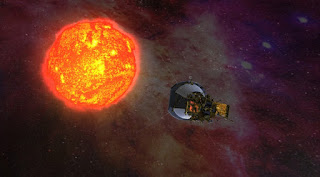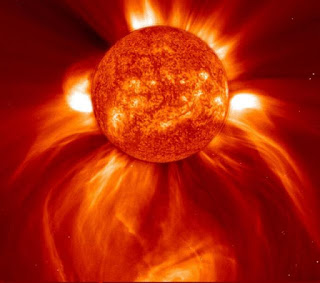NASA’s Parker Solar Probe—Uncovering the Sun’s Secrets Part 1 of 3
NASA’s Parker
Solar Probe—Uncovering the Sun’s Secrets
Part
One
By E. Stanley Ukeni
Like millions of people around
the world, I was awed by NASA’s announcement, on Wednesday, May 31st,
2017, that the United States Space Agency is planning to launch an ambitious
unmanned space expedition to study the Sun, at close proximity.
I decided to write a three part
piece, exploring possible insights into the technology behind the solar probe,
and the potential scientific benefits to be derived from this ambitious
expedition to our sun.
The technologically advance,
10-foot- high, Solar Probe—cased in a nearly 5 inch coat of high-tech
carbon-composite solar shield, is expected to liftoff sometime in the summer of
2018. The 1,350-pound spacecraft is expected to enter orbit deep inside the
sun’s corona sometime in 2024.
The Parker Solar Probe—aptly
named, in honor of Dr. Eugene Parker, the University of Chicago professor who
successfully predicted the existence of solar wind as far back as 1958, is
intended to eventually orbit within about 3.7 miles of the sun’s surface. It is
expected to spend approximately seven years flying to and around the
sun—looping around the planet Venus seven times.
The spacecraft is expected to
receive a gravitational boost during each of its seven elliptical orbital
flybys of Venus—edging closer to the sun’s corona each time, until it reaches
its target proximity.
To put this in prospective, the
solar spacecraft—at a mere four million miles from the sun, will endure
scorching temperatures of about 2,500 degrees Fahrenheit. This is literarily
enough heat to fry the circuits of any spacecraft that NASA has previously
built and deployed to space.
But then, the Parker Solar
Probe is no ordinary spacecraft. Its recently developed carbon composite shield
will serve to protect the craft’s four main instrument groups—keeping them
operating at room temperature, deep inside the sun’s super-hot inferno.
At that proximity to the sun’s
corona, scientists would be able to gain greater insights into the workings of
our Sun with the aid of cutting-edge scientific instrument that the Solar Probe
will be equipped with.
That would put the probe closer
to the sun than any spacecraft has ever reached, in the history of human space
exploration. This ambitious mission, if successful, would be a truly remarkable
scientific feat, and a historic human achievement.
I learnt from my research for
this article that the only other time that man-made craft attempted to closer
observation of our sun was in 1976, when a probe called ‘Helios 2’ came within
27 million miles of the sun. That expedition left scientists with more
questions than answers.
NASA’s stated objectives for
the mission includes, tracing the flow of energy that heats and accelerates the
sun’s corona and solar wind, and determining the structure and dynamics of the
plasma and magnetic fields at the source of the solar wind, and to explore the
mechanisms that accelerate and transport energetic particles.
While these are compelling
enough reasons for NASA to embark on this spectacular solar exploration, I felt
that there is more they are not divulging about the core scientific purpose for
launching the expedition.
After listening to the
Wednesday’s briefing by Nicola Fox—mission project scientist at the Johns
Hopkins University Applied Physics Laboratory, I decided to look into possible
areas of science that would greatly benefit from this solar expedition.
The following are some of the
areas of astrophysics that I think will benefit from NASA’s Parker Solar Probe
voyage to the edge of the sun—our star’s corona:
·
The Parker Solar Probe will probably offer
closer insight into the dynamics of coronal loops emerging from the sun’s
surface layer, the photosphere—the giant filaments of plasma protruding into
the solar atmosphere. The data that would be gathered from this observation
will assist astrophysicists in creating a more detailed and dynamic model of
this turbulent and unpredictable region of the sun.
·
I would imagine that the Probe will analyze a
range of charged particles within the sun’s corona, including energetic
particles emanating from coronal mass ejections—these are explosions emanating
from the sun’s surface. These particles influence conditions on Earth.
·
Instruments within the Parker Solar Probe will
conceivably trace the flow of energy and plasma between the sun’s upper layer
and atmosphere, known as the corona. A long standing problem in solar
astrophysics is explaining exactly why the temperature of the corona region of
the sun is millions of degrees hot, while the temperature of the surface of the
sun rises to mere thousands of degrees. It has always been problematic for
astronomers to image the layer between the surface and the corona of the sun,
known as the chromosphere, but the Parker Solar Probe, at a mere 3.7 million
miles from the sun’s surface, it would be much easier to study it.
·
The Parker Solar Probe will probably be equipped
with sensitive instrumentations to closely monitor the sun’s oscillations.
Scientists have known for a while that the sun emits a resonance that is about
100,000 times lower than the middle C octave, in the musical note. A closer
study of this distinct and subtle sound waves, employing a technique called
helioseismology, will enable Astrophysicists
scientists to gain greater insight into what is occurring all over the
interior of the Sun.
Most tantalizing however, is
the fact that particle physicist have long been on the hunt for exotic
particles from the Sun. I figured that, perhaps, there are instruments on the
Solar Probe designed to detect and analyze the structure and composition of such
hypothetical entities like Axions and Chameleons—particles that may constitute
the makeup of dark matter and dark energy, which our sun may be emitting.
As I pondered on this notion, I
was forcibly inspired with the psychic impulse suggesting that this solar
expedition would, perhaps, discover an even more exotic particle, which I will
here refer to as the ‘Spectrion’ wave-particle—which stabilizes the fusion
process taking place within the sun’s core. This class of particle, I suspect,
had been previously undetectable because they decay rapidly upon reaching the
corona region of the sun.
I would dare to advance a
hypothesis that the photosphere region of the sun is populated with massive
amounts of Spectrion wave-particles. However, they transform into other readily
identifiable particles once they collide with other particles at the
chromosphere region of the sun.
I am of the sense though, that
a small number of these exotic particles migrate onto the corona region before
they are annihilated upon collusion with other particles. If the Parker Solar
Probe can manage to identify and analyze this elusive wave-particle it decays,
physicists will be able to advance the field of nuclear fusion science within a
relatively short period.
These elusive and exotic
Spectrions if discovered and understood, may give our scientists greater
insight into how our sun is able generate a stable nuclear fusion. This
knowledge would in turn considerably advance the science of creating a viable
fusion reactor here on earth. I will delve more into the topic of nuclear
fusion possibilities, and the promise, it holds for the supply of abundant and
unlimited energy to the inhabitants of planet earth, in third part of this
article.
NASA revealed, during its
brief, that the Parker Solar Probe mission is scheduled to terminate in June of
2025. Hopefully by then, scientists would have mastered the science of Nuclear
Fusion Reactor technology.
Authored by E. Stanley Ukeni, ©
2017. All Rights Reserved. This material and other articles or stories posted
on this blog site may not be reproduced, published, broadcast, rewritten or
redistributed, in whole or in part, without prior expressed written permission
from the author, E. Stanley Ukeni.
You are invited to follow E.
Stanley Ukeni on twitter at; @EzStan . You’re equally invited to follow him on
google+. Oh yeah, don’t forget to subscribe to this blog Site. Thanks.
Photo
Credits: NASA;





Comments
Post a Comment